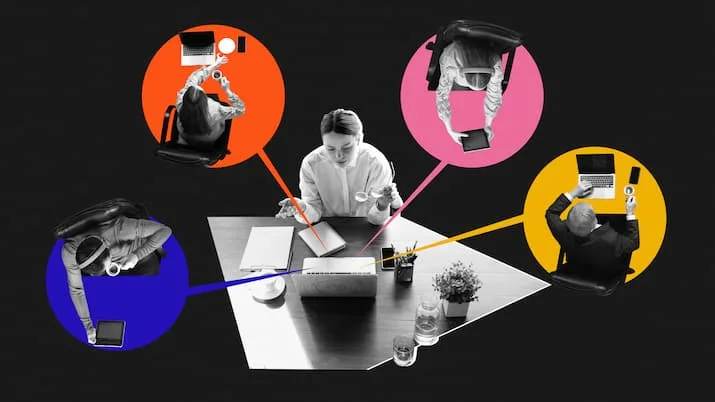How to make a graphic design portfolio
By Open Universities Australia
We break down the essential components of a graphic design portfolio, then give you guidance on selecting your best work and presenting each piece.
What is a graphic design portfolio?
A graphic design portfolio is a gallery of your best design work, carefully curated, beautifully presented and thoughtfully explained. It’s meant to give the viewer a snapshot of your creativity, versatility, attention to detail and problem-solving ability. It should highlight both your capacity to form ideas as well as a deep level of craft.
Think of it as a series of pictorial case studies of your design projects—ones that you’re most proud of.
At a guess, 99.999% of graphic designers put their portfolios on the web. But if the thought of building your own site makes you break out in sweat, you’re not alone.
Luckily, there are heaps of website builders that make it easy to create polished portfolios. Popular ones include Squarespace, Wix or Cargo. Looking for a zero-budget option? Try Crevado or Coroflot. Another bonus is that web builders (more or less) automatically make your site responsive, ensuring that it displays equally well on mobile, tablet and desktop.
What should I put in my graphic design portfolio?
Before discussing how to select projects for your portfolio, let’s talk about the basics of your website. Approach everything with the same consideration and critical eye you’d use on any design project.
The three key sections that should go in your graphic design portfolio are:
About Me section
This should be a short, snappy bio that introduces you, mentions any accolades you may have, your professional (or design study) experience, perhaps one or two fun personal facts and a photo of you. Keep this at around 100 words and try for a friendly, casual tone. If you’re uncomfortable with writing, enlist a writer friend for help!
You may also want to include a link to download your CV. Some people put their CVs in a password-protected section, only providing the password to potential employers during the hiring process.
Contact section
Keep this clean and simple. At the very least, this should have an email address. We recommend including (relevant) social media accounts like your LinkedIn or Instagram. We like Instagram because it allows you to showcase your work more widely and share your design-related views and opinions.
The all-important Work section
First, make a longlist of your favourite projects. We’ll shortlist later. Experts are deeply divided on how many projects to feature, but all agree on quality over quantity. For students and designers just starting out, we recommend four to six projects.
Next, give each project points if it fulfils these factors:
It’s won an award – 1 point
It’s been mentioned in social (or other) media – 1 point
You have statistics that evidence its success – 1 point
A design teacher or mentor has complimented it as being interesting/fresh/out of the box – 1 point
You got an A for it – 1 point
Put any projects that you’ve given points aside—these go into your shortlist and should be featured at the top of your webpage so that a visitor to your site sees them first. The more points, the closer to the top it goes. Make sure you have lots of nice, hi-res images that show off these projects. Gather any early sketches or iterations of your designs as well.
Now look at the rest of your longlist and remove any projects that feel too similar to those on your shortlist. Potential employers will be looking for a variety of mediums and styles. If you already have a great example of packaging design on your shortlist, you should probably cross off other packaging designs from your longlist. What remains goes on your shortlist.
Finally, you have the option to choose a ‘wild card’ entry. This is a project that is experimental and unexpected. Including a project like this shows future bosses that you have ‘stretch’ and can think beyond the brief.
Once you have your shortlist of four to six, collate all your images and sketches.
Hint! You can place projects that don’t make the shortlist on a separate page of your site in a password-protected section. Should a future employer ask for more examples of a particular type of design, you can direct them to the page and provide them with the password (in a similar vein to the CV-related tip above).
Feeling like your portfolio is a little bare? One way to create more work for it and improve your skills is the tried and tested one—a graphic design course. Whether it’s a 10-week short course, 18-month masters degree or 3-year bachelor degree, you’ll be surprised at your own progress.
What to write in a graphic design portfolio?
Employers are interested in your thought process and how you make design decisions. That’s why it’s important to treat each project as a storytelling exercise. Write short, concise descriptors about the brief, your initial impressions and what you thought were challenges and/or opportunities. Accompany these with illustrations of your early ideas—rough sketches or basic visuals work really well here.
If you’ve gone through rounds of iteration with a client or user testing group, speak a little about that too—what you learnt and how you incorporated the feedback to produce an improved design.
By showing the process behind each of your portfolio projects, you’re demonstrating your depth as a thinker and problem-solver. This is your true value as a designer and sets you apart from being just an artworker.
Great graphic design portfolio examples to inspire you
Just like you would at the start of any design project, survey the lay of the land (or in this case, pixel). Keep in mind that these portfolios are of graphic designers who’ve been in the business for years, which is why they feature way more than the four to six projects we recommended to you.
Leta Sobierajski
Bright, bold and with arresting large-scale visuals, Leta’s portfolio shows the application of her designs in situ. She incorporates video on some projects to show how her designs come to life.Louise Brough
Louise lets her personality shine through and gives visitors a good snapshot of each case study she’s included. She even uses logos of her clients on her site—a good tactic to borrow once you have work experience.Wenfei Hu
Sometimes you don’t need a fancy website to showcase your work. Wenfei uses Behance, which comes with a templated interface, but one that still allows you to present pictures and text.Harley Johnston
Harley also explains the background of each project and even lists the outputs of each project in some cases, providing visitors with a clear picture of their contribution. Bonus—they include testimonials in the form of short quotes from happy clients.Abbey Lossing
Caveat! Abbey is an illustrator with a specific style, not a graphic designer. We’ve included her portfolio because it’s a great example of a simple tile-style layout with a basic three-link navigation bar.
For more of the best graphic design portfolio websites, have a look at aggregators like Awwwards.
Fired up and ready to pursue graphic design seriously? These online graphic design courses are delivered by leading Australian universities through Open Universities Australia.



